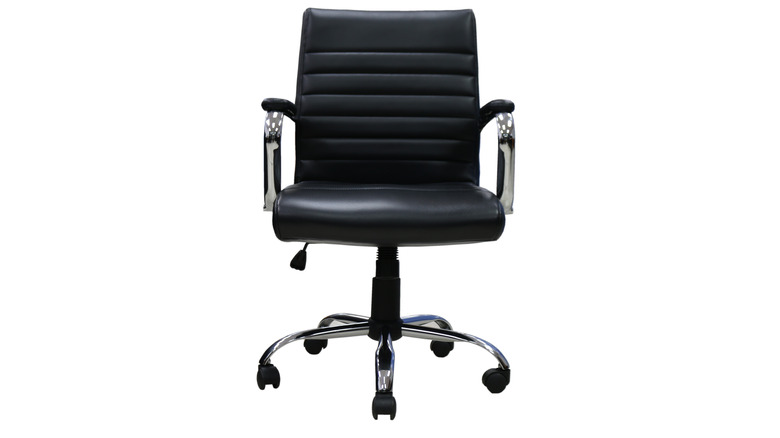Executive Chairs Vs. Task Chairs: What's The Difference?
Working a desk job usually means you are sitting in a chair for the majority of the day. There are several different desk chair options for people who remain seated for long amounts of time, and they vary in purpose and support. Office Interiors says that task chairs were created with the intention of shorter periods spent in them and usually come without arms or embellishments. Executive chairs come with a variety of add-ons that make them ergonomically correct and useful for longer bouts of sitting. Depending on your needs, one or the other can help make workdays more productive and bring your body happiness.
These particular characteristics are not the only differences between the two chairs. Each brings pros and cons to the table, but it really comes down to the user. In order to help you make an educated decision on a chair for your home office, it is best to understand the ins and outs of both before investing in one.
Executive chairs
Executive chairs have a variety of benefits when it comes to long workdays. Fit Small Business points out that executive chairs are made with lumbar support, which aids in protecting your lower back. You can comfortably sit and work in these chairs for up to 8 hours a day, which helps if a job is predominately desk focused. They are larger and heavier, which does mean they take up more space than a task chair. Because of this, you might have problems fitting an executive option in smaller cubicles, offices, or limited space. However, if you have the room, these chairs are fantastic for anyone who spends long hours at their computer.
Executive chairs can be pricier than mid-back or task selections because they come with armrests and are known to be more durable. They are also created from leather or higher quality fabric and usually have the option to recline, swivel, or adjust the height.
Task chairs
Task chairs are great for shorter stints at a desk or table. You can use them comfortably for up to four hours, but beyond that, they aren't always the best for long-term lumbar support. If your job or projects involve a lot of hand or arm movement, these chairs are ideal because there are models without restricting armrests. This allows for more freedom when it comes to upper body motions.
These chairs are known for being light and small, so they can easily fit into a small area without taking up too much room. Task chairs also fit nicely under most desks due to their compact build, whereas executive options can be too big and may have to sit level with a surface. Task chairs are designed to help improve posture, too, according to Office Interiors. They promote neck and back support, providing comfort when you're seated, but they also encourage the user to get up and move. Because they don't come loaded with all the bells and whistles, they are known for making people more productive.
Price range
Both chairs vary in price, as well. The general price range of office chairs is between $100 and $1500. Task chairs that feature good lumbar and shoulder support start around $450, according to Office Interiors, while executive options can cost between $350 and $800. The more you customize, the higher the price will go. When purchasing a mattress or a couch, you look for comfort and support because you spend a good amount of time on it. The same idea should apply when purchasing an office chair -– the more you invest, the better you will feel while using it.
Most ergonomic chairs come with a warranty, which can vary from one year to ten. This depends on everything from the frame to the fabric or material, and each component of the chair might have a different warranty. Cushions might only be protected for one to two years, while the frame might be covered for a decade.
Caring for your office chair
Caring for your office chair is important. While warranties are there for damages or faulty components, general maintenance is the best way to keep your chair in play longer. Most task and executive chairs come with an upholstery tag that explains how to care for the material, which will help guide you when it comes to cleaning. Use a vacuum attachment to get rid of dust and dirt that has accumulated between the seat and other crevices.
Office Chairs Unlimited offers some tips on cleaning chairs, like, if the task or executive chair is leather, apply a conditioner every 2-3 months to prevent cracks and dry spots. With the proper care, office chairs should last you between five and 10 years. The frames can be made from aluminum, steel, or wood. Aluminum alloy is known to be extremely durable, as are heavier nylon bases, both of which are great for withstanding wear and tear. Heavy nylon weighs more, making it a better option for a stationary chair that remains in one place.
Choosing the right chair comes down to need. Do you plan to sit for longer than four hours? An executive chair is best for that. Do you prefer to move around a lot or have less space? Task chairs can accommodate that. Choose lighter bases for fluidity, or heavier bases to withstand wear and tear. While both options have many benefits, it comes down to the user's preferences.




